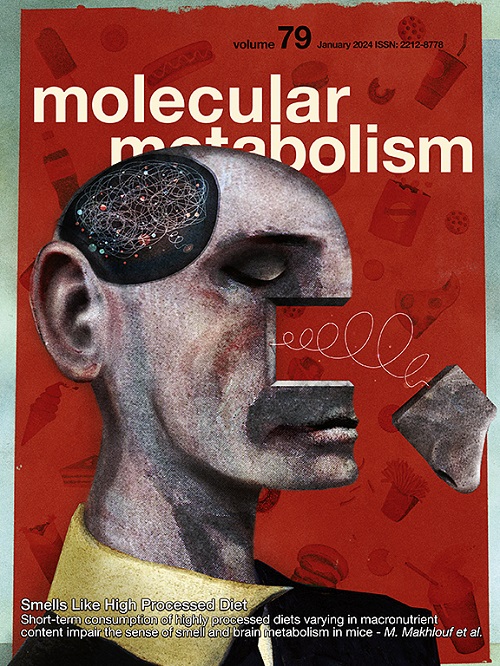CPEB2激活的Prdm16翻译可促进棕色脂肪细胞功能并预防肥胖。
IF 7
2区 医学
Q1 ENDOCRINOLOGY & METABOLISM
引用次数: 0
摘要
目的棕色脂肪组织(BAT)通过表达解偶联蛋白1(UCP1)在哺乳动物的产热过程中发挥着重要作用。我们之前的研究发现,细胞质多腺苷酸化酶结合蛋白 2(CPEB2)是一种关键的调控因子,它能在肾上腺素能信号传导下激活长 3'- 非翻译区 Ucp1(Ucp1L)的翻译。缺乏 CPEB2 或 Ucp1L 的小鼠表现出 UCP1 表达减少和产热受损;然而,只有 CPEB2 缺失的小鼠表现出肥胖表型。因此,本研究旨在探讨 CPEB2 控制的翻译如何影响体重:方法:对全基因敲除(KO)CPEB2、UCP1 或 Ucp1L 的小鼠以及在神经元或脂肪组织中有条件敲除 CPEB2 的小鼠进行体重测量。通过 RNA 测序和生物信息学分析,确定了 CPEB2 基因缺陷型 BAT 中基因表达失调的情况。随后通过 RT-qPCR、Western 印迹、多聚体分析和荧光素酶报告实验证实了 CPEB2 在调控 PRD1-BF1-RIZ1 同源域含 16(PRDM16)表达中的作用。表达 CPEB2 或 PRDM16 的腺相关病毒(AAV)被送入 BAT,以评估它们在减轻 CPEB2-KO 小鼠体重增加方面的功效:结果:我们验证了 BAT 功能缺陷是 CPEB2-KO 小鼠体重增加的原因之一。转录组分析表明,CPEB2-KO BAT 中与肌肉发育相关的基因表达上调。鉴于棕色脂肪细胞和肌细胞都来源于表达肌生成因子 5 的前体,其细胞命运分化受 PRDM16 的调控,我们发现 CPEB2 会上调 Prdm16 的翻译。在CPEB2缺失的BAT中异位表达PRDM16可恢复基因表达谱,并降低CPEB2-KO小鼠的体重增加:结论:除 Ucp1L 外,CPEB2 对 Prdm16 翻译的激活对于维持棕色脂肪细胞的功能至关重要。这些发现揭示了 CPEB2 在转录后调控方面的一个新层次,它可以微调棕色脂肪细胞的产热和代谢活动,从而控制体重。本文章由计算机程序翻译,如有差异,请以英文原文为准。
CPEB2-activated Prdm16 translation promotes brown adipocyte function and prevents obesity
Objective
Brown adipose tissue (BAT) plays an important role in mammalian thermogenesis through the expression of uncoupling protein 1 (UCP1). Our previous study identified cytoplasmic polyadenylation element binding protein 2 (CPEB2) as a key regulator that activates the translation of Ucp1 with a long 3′-untranslated region (Ucp1L) in response to adrenergic signaling. Mice lacking CPEB2 or Ucp1L exhibited reduced UCP1 expression and impaired thermogenesis; however, only CPEB2-null mice displayed obesogenic phenotypes. Hence, this study aims to investigate how CPEB2-controlled translation impacts body weight.
Methods
Body weight measurements were conducted on mice with global knockout (KO) of CPEB2, UCP1 or Ucp1L, as well as those with conditional knockout of CPEB2 in neurons or adipose tissues. RNA sequencing coupled with bioinformatics analysis was used to identify dysregulated gene expression in CPEB2-deficient BAT. The role of CPEB2 in regulating PRD1-BF1-RIZ1 homologous-domain containing 16 (PRDM16) expression was subsequently confirmed by RT-qPCR, Western blotting, polysomal profiling and luciferase reporter assays. Adeno-associated viruses (AAV) expressing CPEB2 or PRDM16 were delivered into BAT to assess their efficacy in mitigating weight gain in CPEB2-KO mice.
Results
We validated that defective BAT function contributed to the increased weight gain in CPEB2-KO mice. Transcriptomic profiling revealed upregulated expression of genes associated with muscle development in CPEB2-KO BAT. Given that both brown adipocytes and myocytes stem from myogenic factor 5-expressing precursors, with their cell-fate differentiation regulated by PRDM16, we identified that Prdm16 was translationally upregulated by CPEB2. Ectopic expression of PRDM16 in CPEB2-deprived BAT restored gene expression profiles and decreased weight gain in CPEB2-KO mice.
Conclusions
In addition to Ucp1L, activation of Prdm16 translation by CPEB2 is critical for sustaining brown adipocyte function. These findings unveil a new layer of post-transcriptional regulation governed by CPEB2, fine-tuning thermogenic and metabolic activities of brown adipocytes to control body weight.
求助全文
通过发布文献求助,成功后即可免费获取论文全文。
去求助
来源期刊

Molecular Metabolism
ENDOCRINOLOGY & METABOLISM-
CiteScore
14.50
自引率
2.50%
发文量
219
审稿时长
43 days
期刊介绍:
Molecular Metabolism is a leading journal dedicated to sharing groundbreaking discoveries in the field of energy homeostasis and the underlying factors of metabolic disorders. These disorders include obesity, diabetes, cardiovascular disease, and cancer. Our journal focuses on publishing research driven by hypotheses and conducted to the highest standards, aiming to provide a mechanistic understanding of energy homeostasis-related behavior, physiology, and dysfunction.
We promote interdisciplinary science, covering a broad range of approaches from molecules to humans throughout the lifespan. Our goal is to contribute to transformative research in metabolism, which has the potential to revolutionize the field. By enabling progress in the prognosis, prevention, and ultimately the cure of metabolic disorders and their long-term complications, our journal seeks to better the future of health and well-being.
 求助内容:
求助内容: 应助结果提醒方式:
应助结果提醒方式:


